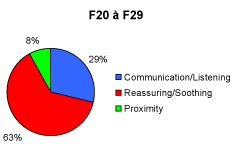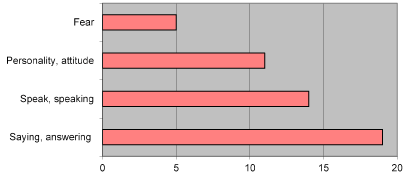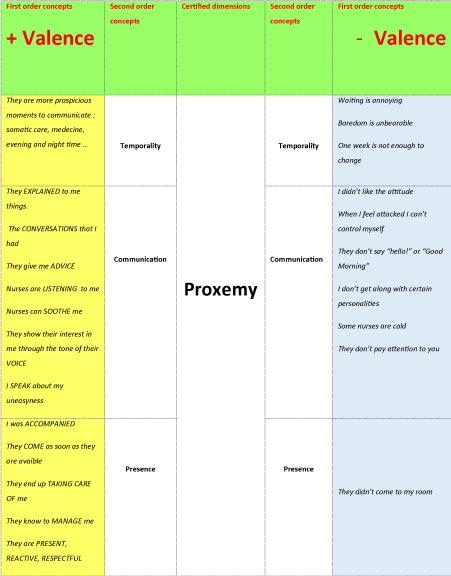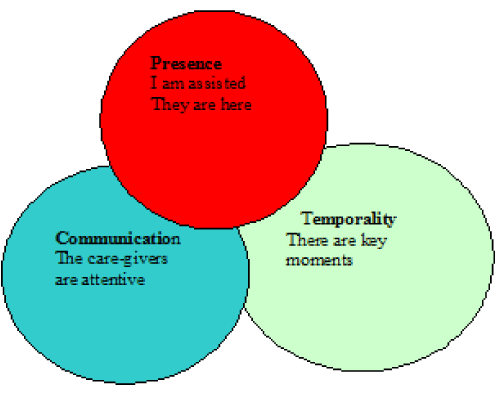Abstract
Background: Since the research of H. Peplau, the question of relational psychiatry has been defined as the heart of the profession of mental health nursing. The therapeutic relationship has evolved in its design to become Therapeutic Alliance (Zetzel), or Helping Alliance (Luborsky) or Working Alliance (Bordin). Recent articles show that these concepts are still very powerful despite the appearance of computer tools and that they are still today major determinants in the management of people suffering from mental disorders.
Objective: To gain insights into the construction of TA from the patients’ perspective. How do patients see the development of the Therapeutic Alliance with nursing staff? And, for example, does the way patients are admitted to hospital (if detained under the mental health act) impact on the formation of TA?
Methods: Qualitative, semi-structured interviews were carried out with patients on acute wards in four inpatients sites, EPS Maison Blanche Paris, between 2014/07 and 2018/07. All interviews were recorded and transcribed, and data were analysed using Nvivo software.
Results: Thirty-one participants were recruited to the study. Reporting of good quality TA did not appear to be linked to whether participants were detained in hospital, nor to their diagnosis. Close proximity is the first value described by patients as a creator of TA and refers to the concept of attachment. We will develop the Proximal Zone of TA (PZTA) concept further in this paper presentation, in addition to our data which indicated that nurses may be sought by inpatients’ as attachment figures as recalled by Gwen Adshead or Kenneth Ma. Three themes were extracted in relation to close proximity: i) during the somatic care (“I am alone with the nurse”); ii) during therapeutic communication face to face “(nurse give me advice”; “they explained me things”; “they listen to me)”; iii) the continued presence (“I was accompanied”; “they know how to manage me”; “they are present; reactive; respectful”).
Introduction
Hildegard Peplau asserted more than half a century ago that the therapeutic relationship was at the heart of the nursing care in psychiatry. Annie Altschul insists, on the necessity of the nurse commitment in care, particularly with patients in psychiatric care [1]. She notes that the nurses are increasingly dissatisfied by their competencies in communication and thus limited in helping patients [2]. A study carried by psychologists [3] show that the nurses are not enough available and not trained adequately to form a real relationship having therapeutic potential with their patients, even though they hold a pivotal position to establish therapeutic alliance. This assessment is also found in other research [4-6]. The Therapeutic Alliance is mainly defined in the form of a face to face relation, but [7], Pulido, et al. delineates the possibility of an Institutional Therapeutic Alliance (ITA). In this way, nurses would be seen by patients as a team, a whole, and so their view of the relationship would not be that of a dual relationship but of a relationship between a patient and a team.
Studies carried out on the nature of the Therapeutic Alliance emphasize this general assessment: The Therapeutic Alliance is a phenomenon that we absolutely have to favour if we want to obtain a psychotherapeutic effect and an observance of a medical treatment [8].
For the majority of authors already quoted, the constructiveness of this Therapeutic Alliance proceeds from two characteristics of the therapist, i.e., the clinician, the caregiver or the nurse. They are 1) His personality, and 2) His therapeutic technique.
Some authors see a contradiction between these two characteristics because it is asked that the nurses work with ‘what they are,’ in other words, their personality, but first of all, they remain professional [9]. Therefore, the research has sought to be precise about the definition of these two characteristics. By personality, we speak from the point of view of relational competencies, without putting aside the clinician’s personality, because his maturity and his conviction are necessary for care; they have an impact on the relational quality. What is remarkable, as well, is Luborsky’s research about similarities between patients and therapists. These similarities favour the setting up of Therapeutic Alliance or Helping Alliance - regarding this researcher the topic he talks about is centered on participants’ ‘addictions.’
At present, Luborsky and his team have identified ten significant similarities: 1) Age, 2) Marital status, 3) Number of children, 4) Religious affiliation, 5) Religious practice, 6) Region of origin, 7) Institutional affiliation, 8) Way of thinking, 9) Upbringing, and 10) Hobbies. These similarities are known by the patient without the need of being clarified [10]. For Bordin, the alliance’s emergence does not depend on the patient or on the therapist, but on the collaboration quality that the therapist and the patient are enabled to develop (1994) – the initial phase of the relation is particularly important for ulterior improvements.
The research shows that the unknown part on this topic is still vast, regarding, in particular, patients presenting schizophrenic ailments. The construction of the Therapeutic Alliance would then represent a real challenge [7].
Frank and Gunderson show that with patients who suffer from acute schizophrenia the first six months are a critical period and that only 29.8% of their sample has been able to establish a good alliance during this period, and those who have not been able to develop it will never develop it after. Therefore, it is very important to be able to assess the possibility of building a Therapeutic Alliance during the hospitalization with the teams who are close to the patients and also who understand what can favour or harm its construction.
Aim
Our study’s aim concerns the identification of the obstacles and the levers which matter in the construction of what we call the Therapeutic Alliance (TA) during the hospitalization, between, on one side, the patients, and, on the other side, the nurses and the assistant nurses, the caregivers. What are the elements which favour, or, at the opposite extreme, inhibit the construction of this alliance? What is the nature of these elements? What is perceived most often as an aid to improving or to debasing the attitudes and behaviours of nurses and assistant nurses?
Method
It is a combined study composed of semi-directed interviews done with patients at the end of their hospitalization. The interviews have been recorded and transcribed, and then analysed in an inductive way in three successive phases: opened encoding, axial encoding, and selective encoding [12]. The encodings have been crossed-referenced with the socio-demographic data and the medical diagnosis of patients.
Results
A description of the persons questioned is made.
31 patients questioned. The interviews lasted between 3 and 27 minutes. A description of the persons questioned is made (Table 1 and 2).
Only the main diagnoses have been catalogued. Specifically, all patients questioned fall within psychiatric troubles or inducing psychiatric troubles (for example, a psychotropic substance intake, or a neurologic trouble which causes behaviour troubles). The International Classification of Disease (ICD-10) published by the World Health Organization (WHO) has been used as reference.
Table 1: Sample description of the patients interviewed (N=31).
Sex/Age |
20-29 |
30-39 |
40-49 |
50-59 |
60-69 |
70 and more |
Female |
4 |
3 |
0 |
2 |
1 |
0 |
Male |
5 |
4 |
7 |
4 |
1 |
0 |
Table 2: Sample description sex/diagnostics.
Sex/Diagnostic |
F10 à F 19 |
F20 à F 28 |
F30 à F38 |
F40 à F48 |
F50 à F58 |
F60 à F68 |
Female |
1 |
4 |
4 |
0 |
0 |
1 |
Male |
1 |
9 |
9 |
1 |
0 |
1 |
Total |
2 |
13 |
13 |
1 |
0 |
2 |
Box 1.
Mr. L.F. attributes to himself the term ‘appropriate surroundings’ to express his state of constrained hospitalization. This is quite remarkable, because this expression, placed the medical care in perspective, shows that the patients have hindsight and reveals all the complexity of care and its positive aspect as well.
L.F., diagnosed with schizophrenic troubles, involuntary hospitalized.
Interviewer: Has it gone well for you? Alright. According to you, what has helped or, at the opposite extreme, what has slowed the remission of your symptoms? In fact, you are getting better, compared to the beginning, to what do you attribute it?
Interviewee: Ah, it is many different things. A particular factor, no, I don’t see.
Interviewer: And about these things, what would you say?
Interviewee: I don’t know. It is perhaps the fact to be in appropriate surroundings. It is perhaps the medicine or mmm…I don’t really know.
Whatever the diagnosis class is, there are always positive elements found linked to the hospitalization setting. Even the persons presenting mood troubles (F30-38) have been able to develop more on this theme. However, we have also found again negative elements linked to hospitalization, especially regarding the removal of certain liberties, phone access, inhibited coming and going.
Box 2.
For Mr. C.S., hospitalization represented a refuge, an asylum as we could formerly have said. The fact that a patient could experience hospitalization as a space of recovered serenity signifies the very good quality of the hospitalization department’s atmosphere, so well that the atmosphere is compared to the one we can find ‘in the mountain!’
Mr. C.S., diagnosed with mood troubles, enrolled in outpatient care. ‘As for me, I have looked for hospitalization exactly to move away. If someone had told me “Look, we offer you a month at the mountain,” I would have gone. I would have gone. I needed to leave that environment.’
The diagnosed patients presenting schizophrenic troubles attach importance to the carers’ reassurance. First, they judge them as efficient and very present. They are on a quest to find a ‘friendly’ or ‘parental’ link which has the potential to leave the caregiver-patient role and to lead towards a person to person relationship (Figure 1).

Figure 1. Ranking of occurrences in 3 categories according to the patients presenting schizophrenic troubles.
The hindrances to the construction of TA for all the interrogated patients.
As shown in the following diagram, the hindrances to the construction of TA arise from the avenues concerning communication. Here, the attitude of the care-giver is the main issue, so much so it can be the cause of fear (Figure 2).

Figure 2. Words of more than four letters that represent a hindrance to TA construction.
Among the one hundred words most used by all the patients, it is ‘listening’ which first appears - it references participation in oral communication - followed by ‘help’ or ‘helped’ which references advice or a presence when anxiety rises. To be noted, ‘nights’ appear in 5th position. ‘Nights’ are described as a privileged time when the department is quieter, and the caregivers are more available. ‘Hand’ appears in 4th position but it is an anomaly because this occurrence has mainly been evocated under various meanings
The inductive analysis of the interviews led us to develope the following thematic tree (Figure 3)

Figure 3. Thematic Tree on the Therapeutic Alliance from the patient's perceptions.
In the positive valence, the patients evocate the relation to time (temporality) by underlining that there are moments more favourable to enter in contact with the caregivers; during the night because the night teams are more available or when they need somatic care, or it is when treatment intake happens. All these moments are opportunities to get closer to the caregivers, which is viewed positively by the patients.
The quality of communication is also noticed as being very positive. Thus, tone of voice can represent an interest marker for the patients. Here again, getting closer, intimacy, is analysed during this mediation, because if the communication is badly received, the caregivers’ behaviour leads to distance, a source of big dissatisfaction.
Finally, presence represents the third important marker. And here again it can be denoted in a binary way, it can create closeness, or, at the opposite extreme, it marks an absence which is also a frustration factor, an abandonment.
Also, there are many expectations from the patients’ side who seek to find the most propitious moments to get an adequate answer for their needs. This expectation is consisted in the research of relational proximity, what we are going to call Proxemics.
Proxemics combines the idea that the caregivers, to be viewed as helping, must embody these three modes: presence, communication, and, finally, temporality. Presence is from a factual and dichotomous order. The view of the caregivers, whether they are present or not, is qualitative: ‘they are respectful,’ ‘they manage well.’
No-show is signalled as the absence of initiative from the caregiver to go in front of the patient.
Regarding communication, it is of two orders. It can have a therapeutic aim, to calm, to listen, but, also, it can be based on the informal, one created by talking. Patients often insist on the second, which refers to the ordinary functions of communication. What they also look for from caregivers is a relationship seeming to have potential, familial or friendship.
Temporality refers more to institutional functioning. Caregivers are busy with tasks at fixed hours (often administrative) and are not available for everyone. Patients report this in the form of a vacuity which goes to the point of boredom. They know then to capture the moments when the caregivers will be available for them, the times of treatment intake, and somatic care, for example. We have designated these times by the term ‘key moments.’
All these dimensions target one aim, seeking the closer proximity of caregivers, not only as a therapist, but also as a person.
Discussion
Previous studies have highlighted the enhancement of relationships based on the trust of psychiatric patients, and the values and the attitudes of nurses, who give care, are considered more important than their technical skills [12,13] other researchers emphasize the availability of nurses for inpatient psychiatric patients [14,15]. Our research, meanwhile, reinforces these findings with the emphasis on proximity -- in the sense of Lev Vygotsky when he proposes the concept of Zone Proximal Development, abbreviated ZPD [16]. We find the two dimensions of ZPD in the relationship between nurses or assistant nurses and patient, namely,
A proximity which is considered necessary,
The fact that the nurse aims to provide assistance to those who are in trouble or playing in this case a reinsurance role.
It is for this reason that we suggest focusing on the Proximal Zone of Therapeutic Alliance, abbreviated PZTA, which can be summarized in the following form (Figure 4).
This concept, derived from developmental psychology and which is adapted for the nurse-patient relationship in psychiatry, shows a different dynamic from that in the references, for example, Winnicott's holding to qualify this relationship [14]. PZTA can only be activated if the caregiver is engaged deeply in the relationship with the patient. For that, it is necessary, first, that this relationship is physically close; that, second, he or she is available and shows the patient his or her willingness and kindness (for example, by the tone voice, as one of the patients interviewed evinces), and, finally, that he or she is listening. This can be done as an aspect of different models: listening-active, therapeutic, or informal. But these different models require experience and reflexive abilities. It is therefore a real commitment on the part of the caregiver; and, it is impossible to think that this relation is without consequence on the person playing the role of nurse or the carer.

Figure 4. The three components of Proximal Zone of Therapeutic Alliance.
Stickley and Freshwater do not hesitate to talk about ‘the art of loving’ when they talk about the relationship in nursing and wonder about the fact that this ‘art of loving’ is judged as unprofessional [17].
Conclusion
A Therapeutic Alliance2021 Copyright OAT. All rights reservant-nurses team and the full-time inpatients, in other words during all the crisis momentum, even when he has been hospitalised without his consent.
The proximity of carers is a central element in the construction of this alliance. It is based on two pillars:
1) The quality of the presence (attitude), which must be reassuring.
2) The ability for caregivers to adapt to different situations, such as knowing how to advise, or having the right gestures that soothe.
In the conclusion, the availability of the caregiver is important. However, a team of psychologists [3] draws attention to the fact that mental health nurses are not sufficiently available nor are they trained to enter a real relationship with a therapeutic potential with the patient, even though they are in the pivotal position to establish such a therapeutic alliance.
It would be useful to explore the possible relationships between this identification of relational quality with theories such as those of attachment [18] or tuning [19] or yet the Durkheim’s concept of anomie [21].
Funding
This research is funded by the French Ministry of Health as part of the nursing and paramedical research program in 2013.
Acknowledgement
To all the co-investigators of this research.
References
- Peplau HE (1991) Interpersonal relations in nursing a conceptual frame of reference for psychodynamic nursing. New York: Springer.
- Altschul AT (1979) Commitment to nursing. J Adv Nurs 4: 123-135. [Crossref]
- Altschul AT (1983) The consumer's voice: nursing implications. J Adv Nurs 8: 175-183. [Crossref]
- Cameron D, Kapur R, Campbell P (2005) Releasing the therapeutic potential of the psychiatric nurse: a human relations perspective of the nurse–patient relationship. Journal of Psychiatric and Mental Health Nursing 12: 64-74.
- De Leeuw M, Van Meijel B, Grypdonck M, Kroon H (2012) The quality of the working alliance between chronic psychiatric patients and their case managers: process and outcomes. Journal of Psychiatric and Mental Health Nursing 19: 1–7.
- McAndrew S, Chambers M, Nolan F, Thomas B, et al. (2014) Measuring the evidence: Reviewing the literature of the measurement of therapeutic engagement in acute mental health inpatient wards: Measuring Therapeutic Engagement. International Journal of Mental Health Nursing 23: 212–220.
- Pulido R, Monari M, Rossi N (2008) Institutional therapeutic alliance and its relationship with outcomes in a psychiatric day hospital program. Archives of Psychiatric Nursing 22: 277–287.
- Forchuk C, Westwell J, Martin ML, Azzapardi WB, Kosterewa-Tolman D, et al. (1998) Factors Influencing Movement of Chronic Psychiatric Patients from the Orientation to the Working Phase of the Nurse-Client Relationship on an Inpatient Unit. Perspectives in Psychiatric Care 34: 36–44.
- Luborsky L, McLellan AT, Woody GE, O'Brien CP, Auerbach A (1985) Therapist success and its determinants. Arch Gen Psychiatry 42: 602-611. [Crossref]
- Hem MH, Heggen K (2003) Being professional and being human: one nurse’s relationship with a psychiatric patient. Journal of Advanced Nursing 43: 101–108.
- Belmas V (1995) L’alliance thérapeutique approche clinique auprès de 70 patients hospitalisés en psychiatrie. Toulouse 3: Sl.
- Lejeune C (2014) Manuel d’analyse qualitative analyser sans compter ni classer. Louvain-la-Neuve: De Boeck Supérieur.
- Read J, Reynolds J (1996) Speaking our minds. Milton Keynes? Open University Press.
- Rogers A, Pilgrim D (1994) Service users' views of psychiatric nurses. Br J Nurs 3: 16-18. [Crossref]
- Johansson H, Eklund M (2003) Patients' opinion on what constitutes good psychiatric care. Scand J Caring Sci 17: 339-346. [Crossref]
- Tehrani ES, Ewald HL, Munk-Jørgensen P (1996) Quality of psychiatric treatment. Determined by patient satisfaction. Ugeskrift for Laeger 158: 158-162.
- Doolittle Peter E (1997) Vygotsky’s Zone of Proximal Development as a Theoretical Foundation for Cooperative Learning 8: 83-103.
- Stickley T, Freshwater D (2002) The art of loving and the therapeutic relationship. Nurs Inq 9: 250-256. [Crossref]
- Bowlby J (1969) Attachment and loss. New York: Basic Books.
- Stern DN (1977) Mère et enfant les premières relations. Bruxelles.
- Durkheim E (1930) Le suicide étude de sociologie. Paris: Presses universitaires de France.




